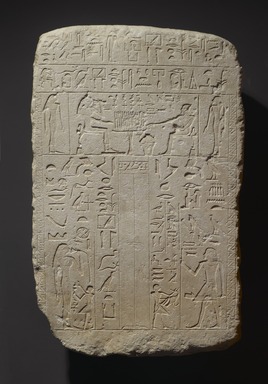
Medium: Limestone
Geograhical Locations:
Dates:ca. 2350–2170 B.C.E.
Dimensions: 25 3/16 x 15 15/16 x 4 1/2 in., 100 lb. (64 x 40.5 x 11.4 cm, 45.36kg)
Collections:
Museum Location: Funerary Gallery 2, Martha A. and Robert S. Rubin Gallery, 3rd Floor
Exhibitions:
Accession Number: 86.226.29
Image: 86.226.29_view1_PS1.jpg,
Catalogue Description:
Rectangular limestone stela in the form of a false door. The piece is inscribed for the Lady Djefatka. Representations and inscriptions are carved in shallow sunk relief. At the top are two lines of inscriptions. The sides of the stela are irregularly rounded, and the top of the first line of text is carved, in part, on the rounded upper edge of the stela. Below the two lines of inscription is a horizontal panel decorated with a representation of the Lady and of a man who is identified as an “overseer of the Army”. The man is seated at the right of a table and the woman is seated on the left. Above and between them is an inscription. This panel is flanked, on each side, by a horizontal panel in which is a representation of a female figure who stands facing inwards towards the main panel. Below these panels are represented the jambs of the door and door proper.
On the drum of the door is an inscription. The bolt of the door is represented. On the right jamb is represented a male figure who stands, facing inwards, holding a staff and scepter. Before him is a small figure who offers to him a duck. Inscriptions identify both figures.
On the left jam is represented the lady Djefatka standing, facing inwards, with a lotus held to her nose. A smaller male figure offers incense to her. Inscriptions accompany the representations. The two panels and the jambs are framed on the two sides of the stela by two-dimensional representations of torus moldings.
Condition: Large chip in lower left corner; sides and rear rough; traces of modern blue paint (?) in upper and lower right.